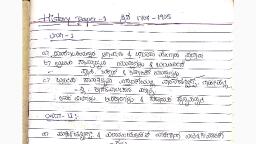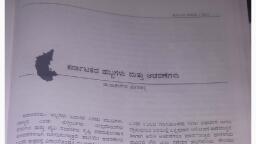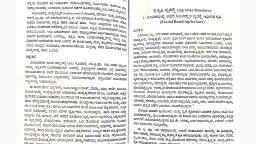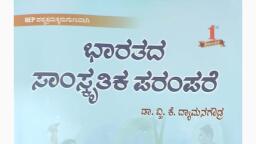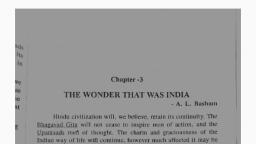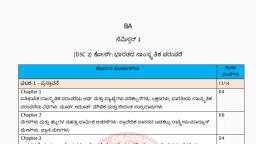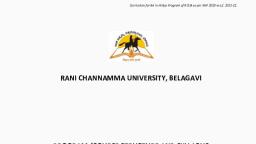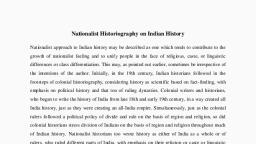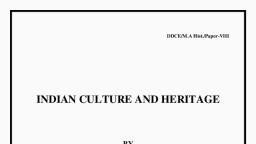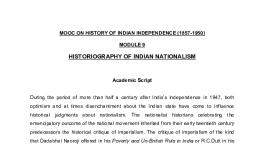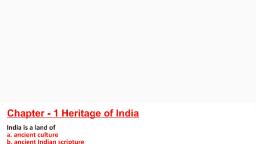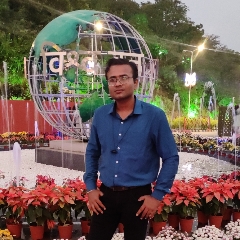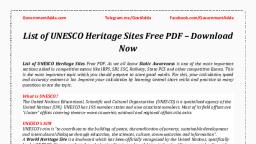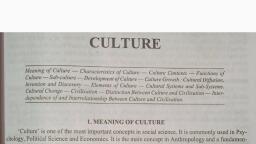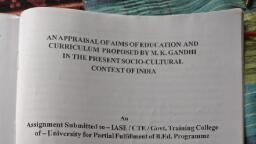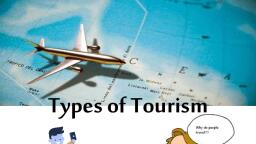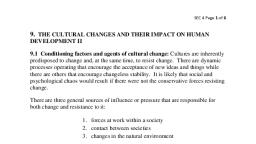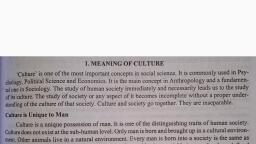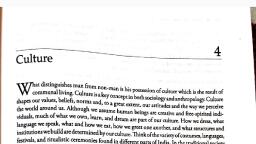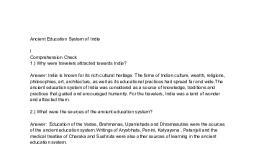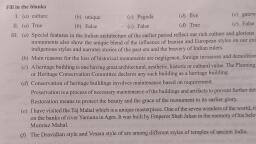Page 1 :
MODULE – 2, , Understanding Indian Culture and Heritage, , Cultural Dimension of, Tourism, , 6, Notes, , UNDERSTANDING INDIAN, CULTURE AND HERITAGE, , India’s cultural heritage is not only one of the most ancient but it is also one, of the most extensive and varied. From ancient times to the present many races, and religions came here and left their imprints on the culture. These people either, came into contact with India temporarily or permanently settled within her, borders to evolve a distinctive Indian culture. This resulted in a synthesis of many, cultures. With the result India, due to its rich and precious Cultural and Natural, heritages, came to be known as the land of great wonders and diversities. The, Culture of India refers to the way of life of the people of India. India’s languages,, religions, dance, music, architecture, food, and customs differ from place to, place within the country. The Indian culture is often labelled as an amalgamation, of several segments of cultures, including traditions that are several millennia, old. It spans across the entire Indian sub-continent. Many elements of India’s, diverse cultural segments have had a profound impact across the world. In its, collective form these cultural traits are identified as Indian cultural heritage. It, is interesting to note that in the 10th century the Arabs described Indian culture, as Ajaib-ul-Hind. The literal meaning of Ajaib-ul-Hind is ‘Incredible India.’, Do you know that these traditions and traditional life styles are inherited from, our rich past? What we inherited from our predecessors is known as heritage., Thus heritage encompasses the history and ideas of people of that country, there, values and beliefs, monuments, sites of important past events such as battle of, Panipat and the battle of Haldi Ghati, which are historically famous. Besides,, in the category of heritage we can include arts such as dance, music (shastriya, sangeet)., Being an oriental ancient civilization, India has a history that is 5000 years old, and its culture which is extensive, profound and unique. All this has made, immense contribution to the world progress and civilization. In this lesson we, shall identify the major characteristic of Indian culture., 90, , TOURISM
Page 2 :
Understanding Indian Culture and Heritage, , MODULE – 2, Cultural Dimension of, Tourism, , OBJECTIVES, After studying this lesson, you will be able to:, z, , describe the meaning and concept of culture and heritage;, , z, , identify characteristics of Indian Culture;, , z, , discuss the cultural identity, religion, region and ethnicity of Indian Culture, and, , z, , explain the characteristics of Indian Heritage., , Notes, , 6.1 MEANING AND CONCEPT OF CULTURE AND, HERITAGE, The word ‘Culture’ is derived from the Latin term ‘cult or cultus’ meaning tilling,, or cultivating, refining and worship. Summing up, it means cultivating and, refining a thing to such an extent that its end product evokes our admiration, and respect., The food you eat, the clothes you wear, the language you speak, the God you, worship, all are aspects of culture. In very simple terms, we can say that it is, the embodiment of the way in which we think and do things. It is also the things, that we have inherited as members of society. All the achievements of human, beings as members of social groups can be called culture. Art, music, literature,, architecture, sculpture, philosophy, religion and science can be seen as aspects, of culture. However, culture also includes the customs, traditions, festivals, ways, of living and one’s outlook on various issues of life., Culture thus refits to a human-made environment which includes all the material, and non-material products of group life that are transmitted from one generation, to the next., Culture is the expression of our nature in our modes of living and thinking. It, may be seen in our literature, in religious practices, in recreation and enjoyment., Culture has two distinctive components, namely, material and non-material., Material culture consists of objects that are related to the material aspect of, our life such as our dress, food and household goods. Non-material culture refers, to ideas, ideals, thoughts and belief., Culture varies from place to place and country to country. Its development is, based on the historical process operating in a local, regional or national context., For example, we differ in our ways of greeting others, our clothing, food habits,, social and religious customs and practices from the West. In other words, the, people of any country are characterised by their distinctive cultural traditions., TOURISM, , 91
Page 3 :
MODULE – 2, Cultural Dimension of, Tourism, , Notes, , Understanding Indian Culture and Heritage, , Cultural development is a historical process. We have learnt many things from, our ancestors. As time goes, we continue to add new thoughts, new ideas to, those already existent and sometimes we give up some which we don’t consider, useful any more., Cultural heritage includes all those aspects or values of culture transmitted to, human beings from their ancestors from generation to generation. They are, cherished, protected and maintained by them with unbroken continuity and they, feel proud of it., A few examples would be helpful in clarifying the concept of heritage. The Taj, Mahal, Swami Narayan Temple of Gandhinagar and Delhi, Red Fort of Agra,, Delhi’s Qutub Minar, Mysore Palace, Jain Temple of Dilwara (Rajasthan), Nizamuddin Aulia’s Dargah, Golden Temple of Amritsar, Gurudwara Sisganj of, Delhi, Sanchi Stupa, Christian Church in Goa, India Gate etc., are all important, places of our heritage and are to be protected by all means., Besides the architectural creations, monuments, material artifacts, the intellectual, achievements, philosophy, treasures of knowledge, scientific inventions and, discoveries are a part of heritage. In Indian context, the contributions of, Baudhayan, Aryabhatta, Bhaskaracharya in the field of Mathematics, Astronomy, and Astrology; Kanad and Varahmihir in the field of Physics; Nagarjuna in the, field of Chemistry, Susruta and Charak in the field of Medicines and Patanjali, in the field of Yoga are profound treasures of Indian Cultural heritage. Culture, is liable to change, but our heritage does not. We individuals, belonging to a, culture or a particular group, may acquire or borrow certain cultural traits of, other communities/cultures, but our belongingness to Indian cultural heritage, will remain unchanged. Our Indian cultural heritage will bind us together e.g., Indian literature and scriptures namely Vedas, Upanishads, Gita and Yoga, System etc. have contributed a lot by way of providing right knowledge, right, action, behavior and practices as complementary to the development of, civilization., , 6.2 CHARACTERISTICS OF INDIAN CULTURE, Look at the map of India and you see India is a vast country with a lot of diversity, in her physical and social environment. We see people around us speaking, different languages, having different religions and practising different rituals. You, can also see these diversities in their food habits and dress patterns. Besides,, look at the myriad forms of dance and music in our country. But within all these, diversities there is an underlying unity which acts as a cementing force. The, intermingling of people has been steadily taking place in India over centuries., A number of people of different racial stock, ethnic backgrounds and religious, beliefs have settled down here., 92, , TOURISM
Page 4 :
Understanding Indian Culture and Heritage, , 6.2.1 Continuity and Change, , MODULE – 2, Cultural Dimension of, Tourism, , Despite major changes and upheavals significant threads of continuity can be, traced throughout the course of Indian history right upto the present day., Harappan civilization flourished in the Indian subcontinent over 4500 years ago, and it also had trade with Mesoptamian and Chinese Civilization. Archaeologists, have found evidences to show that cultures existed here even before the matured, phase of the Harappan civilisation. This tells us that we have a very long history, behind us. And yet what is amazing is that even today the pattern of a house, in an Indian village is not very different from that of a Harappan house. Some, aspects of Harappan culture are still practised, such as, the worshipping of, Mother Goddess and Pashupati. Similarly, Vedic, Buddhist, Jain and many other, traditions continue to be followed even today. It has kept on discarding what, was becoming irrelevant in the modern age. The reform movements in the Vedic, religion brought about by Jainism and Buddhism in sixth century BCE and the, religious and social awakening in the eighteenth and nineteenth centuries in, modern India are a few examples when revolutionary changes were brought, about in Indian thought and practices. Yet the thread of basic philosophy of, Indian culture continued and still persists. Thus a process of continuity and, change has always been a feature of Indian culture. This shows the dynamic, character of our culture., , Notes, , 6.2.2 Variety and Unity, Few cultures in the world have such variety as the Indian culture. You may, perhaps wonder why the people of Kerala use coconut oil while the people of, Uttar Pradesh use mustard oil for cooking. This is because Kerala is a coastal, state and coconut grows here in plenty, while Uttar Pradesh is a plain area which, is favourable for the growth of mustard. What is the similarity in the Bhangra, dance of Punjab or the Pongal of Tamil Nadu or the Bihu dance of Assam? All, are celebrated after a rich harvest of crops. Have you noticed the different, languages that we speak like Bengali, Tamil, Gujarati or Oriya? India is the home, of many forms of dance and music which we normally use for festivals and social, functions like marriages or the birth of a child., A large number of languages and dialects are spoken in our country which has, led to the growth of a great variety of literature. People belonging to eight great, religions of the world co-exist here in a harmonious manner. Do you know that, India is home to many religions of the world like Jainism, Buddhism, Sikhism, and of course Hinduism. Numerous styles of architecture, sculpture and painting, have developed here. Different styles of music and dance, both folk and classical,, exist in the country. So also are numerous festivals and customs. This wide, variety has led to the making of Indian culture both composite and rich and, TOURISM, , 93
Page 5 :
MODULE – 2, Cultural Dimension of, Tourism, , Notes, , Understanding Indian Culture and Heritage, , beautiful at the same time. Why is there so much variety in our culture? There, are many reasons for this. The vastness of the country and variation in its physical, and climatic features is an obvious reason for the variety., The second important reason for the variety in our culture is the intermingling, among various ethnic groups. Since time immemorial, people from far and near, have been coming and settling here. We find people belonging to different racial, stocks like the Proto-Australoids, the Negnoids and the Mongoloids living in, India. Various ethnic groups like Iranians, Greeks, Kushanas, Shakas, Hunas,, Arabs, Turks, Mughals and Europeans also came to India, settled here and, intermixed with the local population. The people belonging to other cultures, brought their cultural habits, thoughts and ideas, which got amalgamated into, the existing culture.The latest is the introduction of shirts, trousers, skirts, etc., which were brought by the Europeans in the sixteenth century. The word roti, (bread) is a Turkish word and sambosa or samosa came from central Asia. Also, Sherwani, an attire which is generally worn by Indian subcontinent bridegroom, is a dress of Sherwan people of Central Asia. Red chilly was brought by the, Marathas to North India in the eighteenth century. Thus India through the ages, has shown a remarkable capacity for assimilation of different habits and ideas., This has contributed to the variety and richness of our culture., Along with contact with outside cultures, cultural exchange between different, regions of India has also continued. The Chikan work of Lucknow, Phulkari, embroidery of Punjab, Kantha embroidery of Bengal, Patola of Gujarat show, a distinct regional flavour. Although the centres in the South, North, East and, West of India have their characteristic cultures, yet these did not develop in, absolute isolation. Inspite of physical barriers, Indians used to travel from one, part of the country to another for trade or pilgrimage. Some regions were joined, together through conquests or by alliance. As a result, people transmitted, cultural habits from one part of the country to the other. Military campaigns, too took people from one place to another. This helped in exchanging ideas., Such contacts have led to the development of commonness in Indian culture,, which has been maintained throughout our history. Another unifying factor is, climate. Despite geographical diversity and climatic variations India experiences, an inherent unity. The system of monsoons is the most important component, of the Indian climatic pattern and this gives unity to the whole country. The, coming of the monsoon has ensured that agriculture remains the main occupation, of the people of India. On the other hand, the differences in physical features, have affected the food habits, dress, houses and economic activities of people, leading to the formation of social, economic and political institutions. These, factors in turn influenced the thinking and philosophy of the people. The variety, in physical features and climate of India has thus led to the development of a, variety of cultures in different regions. The typical features of different regions, have given some identity to these cultures., , 94, , TOURISM
Page 6 :
Understanding Indian Culture and Heritage, , The composite nature of our culture is reflected in our music; dance forms,, drama and art forms like paintings, sculpture and architecture as well. Our, literature in different languages also reflects this composite nature. Unity in, diversity is reflected in our political forms as well. During the early Vedic period,, society was pastoral, that is, people used to move from place to place in search, of pastures. But as these people started practising agriculture, they settled down., This settled life led to community development and growth of towns which, needed rules and regulations. Thus emerged a political organisation. This, included the Sabhas and Samitis which were political bodies through which, people participated in governance. In course of time, the concept of rashtra, emerged and possession of territory became the new measure of power. In some, places, republics came up. The period from sixth to fourth century BCE is known, as the age of mahajanapadas in India. In these kingdoms kings had more powers., Subsequently, large empires were also established with emperors exercising, absolute powers. You may be aware of ancient rulers such as Ashoka,, Samudragupta and Harshavardhana. The Mughals also established a vast empire, in India. The British established themselves in India and in 1858, India became, a part of the British Empire. However, in 1947, we were able to gain our freedom, after a long struggle. Today we are a sovereign, socialist, secular and democratic, republic and a uniform system of government prevails over the length and, breadth of the country., , MODULE – 2, Cultural Dimension of, Tourism, , Notes, , 6.2.3 Secular Outlook, You are aware that there is a great variety of thoughts and habits in our country., Among such a variety, dominance of one particular thought is not possible. You, will recall that Hindus, Muslims, Christians, Sikhs, Buddhists, Jains, Parsees and, Jews live in India. The Constitution declares India to be a secular country., Everyone is free to profess, practice and propagate any religion of their own, choice. The state has no religion of its own and all religions are treated equal, by the state. No one is to be discriminated on the basis of religion. The people, have to a large extent, developed a broad outlook and they believe in the concept, of live and others live., 6.2.4 Universalism, The concept of co-existence has not been confined to the geographical and, political boundaries of the country only. India has a universal outlook and it has, been promoting the message of peace and harmony to the entire world. India, has been raising a strong voice against racialism and colonialism. It has protested, against the formation of power blocks in the world. In fact India became one, of the founder members of the Non-Aligned Movement. India is committed to, the development of other under developed nations. In this manner, India has, TOURISM, , 95
Page 7 :
MODULE – 2, Cultural Dimension of, Tourism, , Understanding Indian Culture and Heritage, , been discharging her responsibilities as a part of the world fraternity and has, been contributing to the progress of the world., It has to be remembered that the subcontinent of India has been one cultural, unit throughout the ages, cutting across political boundaries., , ACTIVITY 6.1, , Notes, 1., , On the map of India Identify the Heritage sites in India., , 2., , Identify the major Cultural Heritages and give examples in support of your, answer. Paste these examples with the pictures to show their characteristics., , INTEXT QUESTIONS 6.1, 1., , Name the state where Bhangra is a popular dance form., , 2., , What is the dance form of Assam known as?, , 3., , Which region is famous for Kantha Embroidery?, , 6.3 CULTURAL IDENTITY, RELIGION, REGION AND, ETHNICITY, Our cultural identities are based on various factors such as religion and region., As a result each Indian possesses multiple identities. Which of these identities, asserts itself at a certain point of time and prevails over the others, depends, on the political, social or economic context which people find themselves in., Thus each person may have some things in common with another, but may be, vastly different in some other aspects. For example, except belief, forms of, worship and rituals, there may be little that is common among those who follow, a particular faith from the point of view of the whole country. Even in the forms, of worship and rituals there are sectarian and regional differences., But you will also find that people of different religions and jatis may have, common regional cultural traits like language, food, dress, values and also the, world view. In Bengal, both Hindus and Muslims take pride in being Bengalis., Elsewhere, one finds Hindus, Christians and Muslims sharing several elements, of regional culture., Ethnic culture is strong among the tribal groups. For example, in the small state, of Nagaland, there are more than a dozen tribes and they differ from each other, in their dress, speech and beliefs. Bastar district of Chhattisgarh has several, groups claiming different ethnic origin., 96, , TOURISM
Page 8 :
Understanding Indian Culture and Heritage, , MODULE – 2, Cultural Dimension of, Tourism, , INTEXT QUESTIONS 6.2, 1., , Give two examples of people who came to India from outside and settled, here., , 2., , Name the civilization with which the Harappans were known to have had, trade relations across the seas., Notes, , 6.4 CHARACTERISTICS OF INDIAN HERITAGE, Heritage is that which is inherited. Heritage is something which is specific and, typical of a particular place, area, region or country on the one hand and of, a family, community or people on the other. It is both natural and human made, created or evolved during the course of history., The glorious past of India has ensured that the present and subsequent, generations have plenty of historical, cultural and natural heritages to be proud, of. The fascinating monuments and heritage sites in the country stand quietly, today to tell their story of joy, sorrow, courage and sacrifice before tourists., Each of the stories is so enchanting and singular that tourists will be left asking, for more at the end of each narration., For centuries, people migrating to India, with their respective cultures and, traditions and later mixing with the cultures and tradition of the Indians has given, birth to a new heritage and culture. This amalgamation of cultures has slowly, but gradually enriched the values and faiths of the Indians even further. As a, result Hinduism, Buddhism. Islam, Jainism and Christianity have made India one, of the largest secular countries of the World where Diwali, Christmas, Eid and, Buddha Jayanti are celebrated with equal enthusiasm and exuberance., As one turns the pages of history, the rich heritage of India comes alive with, all its fragrance and colour which are still breathing in the heritage forts, palaces,, temples and monuments which can be found in each and every corner of this, multi-faceted country, like India. The splendid architecture, minutely carved, motifs, embellished facades of the heritage monuments narrates the immense, skill of the craftsmen which have been fascinating the World for many centuries., When foreign tourists visit India they may not be able to see the entire heritage, sites of India as these are far too many., UNESCO has come up with the mission to protect these treasures which are, the finest gifts to World from India. Be it the exquisite craftmanship and marble, inlay work of the Taj Mahal or the sculptures of the Khajuraho Temples or the, TOURISM, , 97
Page 9 :
MODULE – 2, Cultural Dimension of, Tourism, , Notes, , Understanding Indian Culture and Heritage, , excellent fusion of science and art in Konark Sun Temple, Indian heritage sites, are the manifests to the extremely rich heritage of India. By preserving them, we will leave behind a very rich cultural heritage for our future generations., The number of important monuments and sites in India is so great that a single, tour to discover the multifarious facets of its wonderful heritage is not enough., Nevertheless, it will give tourists an admirable glimpse into the Indian history, and heritage. At the end of their trip, they will surely develop a huge respect, for the Indian heritage while craving for more such tours in the near future., Culture and Heritage provides varieties of tourist attractions. For these reasons, they are core components of tourism., Heritage is the legacy of natural features or cultural attributes in tangible and, intangible form inherited from past generations which are maintained in the, present and bestowed for the benefit of future generations., Cultural heritage includes tangible culture such as buildings, monuments,, landscape books, works of art, and artefacts. Intangible culture also forms an, important part of culture such as folklore, traditions, language, and knowledge., It is evolved through creation, imagination, intelligence, skills, and artistic, abilities of the people over a long period of time., Natural heritage includes culturally significant landscapes and biodiversity., Natural heritage presents a kaleidoscope of geographical and environmental, features which include natural features such as high lofty mountains and hills,, mighty rivers to small rivers, rivulets and streams, dense forest, desert and a, long coastline., India boasts a total of 166 National Parks and 515 Wildlife Sanctuaries,, sheltering over 390 mammals, 455 reptiles, 210 amphibians, 1,230 bird species, and 30,000 species of insects, which make it a perfect destination for wildlife, heritage., Heritage is Broadly Classified as, Tangible Heritage, Tangible heritage is the built heritage which is visible or seen. It comprises of, physical objects, materials in concrete form etc. such as coins, monuments,, artefacts, sculptures, seals, inscriptions. Items collected over a long period of, time, objects in concrete forms preserved in museums can be seen and touched., Intangible Heritage, It is living heritage invisible, unseen but observable. It includes host of things, ranging from ideas to traditions, living styles, practices, beliefs, customs etc.,, , 98, , TOURISM
Page 10 :
Understanding Indian Culture and Heritage, , Behavioural traits such as truth, sincerity, honesty, humility form part of the, character building qualities of an individual which arc perceived but cannot be, seen. Intangible Cultural Heritage means the practices, representations,, expressions, knowledge, skills as well as the instruments, objects, artefacts and, cultural spaces associated with communities, groups and, in some cases,, individuals and recognises it as part of their cultural heritage., The intangible cultural heritage transmitted from generation to generation, is, constantly recreated by communities and groups in response to their environment,, their interaction with nature and their history and provides them with a sense, of identity and continuity. This promotes respect for cultural diversity and human, creativity., , MODULE – 2, Cultural Dimension of, Tourism, , Notes, , Natural Heritage, Natural heritage includes natural features like mountains, forest, deserts, rivers,, flora, fauna, large water bodies like seas and oceans etc. These are not the, creation of the human beings but are gifts of nature and are exposed to natural, agents of erosion, degradation, depletion and pressure of people on the, resources etc., Cultural Heritage, Cultural Heritage is human centric and evolved through creation, imagination,, intelligence, skills, artistic abilities of the people over a long period of time., These are the cumulative result of different practices of both religion and society., These can be seen in customs, dance, music, loud-habits, living life styles,, physical and behavioural patterns. These have undergone a period of transition, from ancient, medieval and modern times., , ACTIVITY 6.2, 1., , Collect the pictures of major Natural and Cultural Heritages of India and, paste them in your scrap book, , INTEXT QUESTIONS 6.3, 1., , Define the concept of Heritage., , 2., , Name different types of Heritages., , TOURISM, , 99
Page 11 :
MODULE – 2, Cultural Dimension of, Tourism, , Understanding Indian Culture and Heritage, , 3., , Differentiate between Tangible and Intangible Heritages with suitable, examples., , 4., , With the help of suitable examples, describe major features of Natural, Heritages., , WHAT YOU HAVE LEARNT, Notes, , 100, , Now let us discuss some general characteristics, which are common to different, cultures throughout the world., z, , Culture is learned and acquired: Culture is acquired in the sense that there, are certain behaviours which are acquired through heredity. Individuals, inherit certain qualities from their parents but socio-cultural patterns are not, inherited. These are learnt from family members, from the group and the, society in which they live. It is thus apparent that the culture of human beings, is influenced by the physical and social environment through which they, operate., , z, , Culture is shared by a group of people: A thought or action may be called, culture if it is shared and believed or practiced by a group of people., , z, , Culture is cumulative: Different knowledge embodied in culture can be, passed from one generation to another generation. More and more knowledge, is added in the particular culture as the time passes by. Each may work out, solution to problems in life that passes from one generation to another. This, cycle remains as the particular culture with time., , z, , Culture changes: There is knowledge, thoughts or traditions that are lost, as new cultural traits are added. There are possibilities of cultural changes, within the particular culture as time passes., , z, , Culture is dynamic: No culture remains in a permanent state. Culture is, changing constantly as new ideas and new techniques are added and as time, passes they keep modifying or changing the old ways. This is the characteristic, of culture that stems from the culture’s cumulative quality., , z, , Culture gives us a range of permissible behaviour patterns: It involves, how an activity should be conducted, how an individual should act, appropriately., , z, , Culture is diverse: It is a system that has several mutually interdependent, parts. Although these parts are separate, they are interdependent on one, another forming culture as a whole entity., , z, , Culture is idealistic: Often it lays down an ideal pattern of behaviour that, is expected to be followed by individuals so as to gain social acceptance, from the people belonging to the same culture., TOURISM
Page 12 :
MODULE – 2, , Understanding Indian Culture and Heritage, , Cultural Dimension of, Tourism, , TERMINAL EXERCISE, 1., , What are the different components of culture?, , 2., , Give the meaning of material and non-material culture., , 3., , Define the secular character of Indian culture., , 4., , Describe the distinctive features of Indian culture., , 5., , Write short notes on the following:, , Notes, , a) Cultural synthesis in India, b) Spirituality, c) Adaptability as a characteristic of Indian culture, 6., , Explain in detail unity in diversity in the context of Indian culture., , 7., , What is Culture? Discuss with examples the main characteristics and values, of Indian Culture., , 8., , How do Culture and Heritage form core components of Tourism?, , 9., , Discuss the different kinds of heritages with appropriate examples from, India., , ANSWER TO INTEXT QUESTIONS, 6.1, 1., , Punjab, , 2. Bihu, , 3. Bengal, , 6.2, 1., , Kushans and Mughals, , 2. China and Mesopotamia, , 6.3, 1., , It is learned and acquired for more information refer section 6.4, , 2., , Tangible, Intangible, Natural, Cultural, , 3., , Tangible is visible like coins, monuments, artefacts, real sculpture etc., Intangible is invisible like style particles, and customs etc., , 4., , Natural heritage like birds, trees, forests and rivers etc. Refer section 6.4., , TOURISM, , 101







